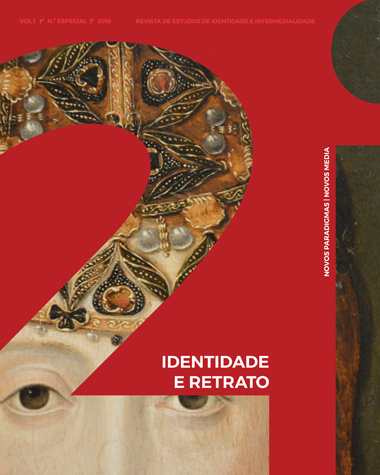A História e a Testemunha de um Massacre como Estratégias e Temas Literários no Romance Gráfico 'Peterloo: Witnesses to a Massacre' (2019)
DOI:
https://doi.org/10.21814/2i.2208Palavras-chave:
romance gráfico histórico; cultura visual; textualização do passado, comics, Massacre de Peterloo.Resumo
O presente artigo analisa de que forma o uso da história como narrativa textual e ideológica se assume como uma estratégia e tema literários no romance gráfico realista Peterloo: Witnesses to a Massacre, publicado colectivamente em 2019 pelo historiador Robert Poole, autor do recente estudo Peterloo: The English Uprising (Oxford University Press), também baseado em 400 relatos de testemunhas coevas, e pelos artistas Eva Schlunke e Polyp. Analisamos a forma como o romance é constituído sobretudo por imagens ficcionadas a partir das fontes históricas coevas e por citações desses mesmos documentos que permitem ao leitor criar a ilusão de um contacto mais directo com o passado textualizado e imaginado através das ilustrações, que, por seu turno, funcionam também como narrativas autónomas e alternativas.
Downloads
Referências
Baetens, J. (2002). Revealing traces. A new theory of graphic enunciation. In R. Varnum & C. T. Gibbons (eds), The language of Comics: Word and image (pp.145–155). Mississippi: Univeristy Press of Mississipi.
Baetens, J. & Frey, H. (2015). The Graphic Novel: An introduction. Cambridge: Cambridge University Press.
Baetens, J., Frey H. & Tabachnick, S. E. (2018). Introduction. In J. Baetens, H. Frey, & S. E. Tabachnick (eds), The Cambridge history of the Graphic Novel (pp.1–18). Cambridge: Cambridge University Press.
Bennett, J. (2005). Empathic vision: Affect, trauma, and contemporary art. Stanford: Stanford University Press.
Blocker, J. (2009). Seeing witness: Visuality and the ethics of testimony. Minneapolis: University of Minnesota Press.
Boltanski, L. (1999). Distance suffering: Morality, media and politics. Cambridge: Cambridge University Press.
Christiansen, H.-C. (2000). Comics and Films: A narrative perspective. In A. Magnussen & H.-Ch. Christiansen (eds), Comics and culture (pp.107–121). Copenhaga: Museum Tusculanum Press.
Clüver, C. (1997). Estudos Interartes: Conceitos, termos, objetivos. Literatura e sociedade, 2, 37–55.
Chute, H. (2017). Why Comics? From underground to everywhere. Nova Iorque: Harper Collins.
Cutter, M. J. & Schlund-Vials, C. J. (2018). Redrawing the historical past: History, memory, and multiethnic Graphic Novels. Athens: University of Georgia Press.
Davies, P. F. (2019). Comics as communication: A functional approach. Londres: Palgrave.
Demson, M. e Hwitt, R. (Eds.) (2019). Commemorating Peterloo: Violence, resilience and claimmaking during the Romantic Era. Edinburgo: Edinburgh University Press.
Earle, H. E. H. (2019). Comics, trauma, and the new Art of War. Jackson: University Press of Mississippi.
Eisner, W. (2008). Comics and Sequential Art. Nova Iorque: WW Norton.
Eisner, W. (2008). Graphic storytelling and visual narrative. Nova Iorque: W. W. Norton.
Fawaz, R. (2016). The new mutants: Superheroes and the radical imagination of american Comics. Nova Iorque: New York University Press.
Fresnault-Deruelle, P. (1976). Du Linéaire au tabulaire. Communications 24: La Bande Dessinée et son Discours, 7–23.
Fresnault-Deruelle, P. (2008). Images à mis-mots: Bandes Dessinées, Dessins d’humour. Impressions Nouvelles: Bruxelas.
Frey, H. (2017). Historical Fiction. In S. E. Tabachnick (ed), The Cambridge companion to the Graphic Novel (pp. 80–96). Cambridge: Cambridge University Press.
Gaudreault, A. & Marion, P. (2004). Transécriture and narrative mediatics: The stakes of Intermediality. In R. Stam & A. Raengo (eds), A companion to Literature and Film (pp.58–70). Oxford: Blackwell.
Gell, A. (1998). Art and agency: An anthropological theory. Oxford: Oxford University Press.
Gil, J. (2004). Portugal, hoje: O medo de existir. Lisboa: Relógio d’Água.
Gordon, I., Jancovich, M. & McAllister, M. P. (Eds). (2007). Introduction: Film and Comic Books. Jackson: University Press of Mississippi.
Groensteen, T. (2007). The system of Comics. Jackson: The University Press of Mississippi.
Hargreaves, R. & Hampson, A. (2018). Beyond Peterloo: Elijah Dixon and Manchester’s forgotten reformers. Filadélfia: Pen & Sword History.
Hatfield, C. (2005). Alternative Comics: An emerging literature. Jackson: University Press of Mississippi.
Hatfield, C. (2009). The art of tensions. In J. Heer e K. Worcester (eds), A Comics studies reader (pp.132–148). Jackson: University Press of Mississippi.
Heer, J. & Worcester, K. (2009). A Comic studies reader. Jackson: The University Press of Mississippi.
Iadonisi, R. (Ed) (2012). Graphic history: Essays on Graphic Novels and/as History: Newcastle upon Tyne: Cambridge Scholars Publishing.
Jakobson, R. (1971). Selected writings: Word and language 2. Haia: Mounton. Krauss, R. (1999). “A voyage on the North Sea”: Art in the age of the post-medium condition. Londres: Thames and Hudson.
Krauss, R. (2010). Perpetual inventory. Cambridge: MIT Press.
LaCapra, D. (2014). Writing History, Writing trauma. Baltimore: John Hopkins University Press.
Marion, P. (1991). Traces en cases. Lovaina: Universidade Católica de Lovaina.
McCloud, S. (2006). Making Comics: Storytelling secrets of Comics, Manga and Graphic Novels. Nova Iorque: Harper Perennial.
Morgan, A. (2019). Ballads and songs of Peterloo. Manchester: Manchester University Press.
Moura, P. D. V. (2008). Memória da Banda Desenhada: Presença e leituras da memória em sete casos da Banda Desenhada contemporânea francófona. Dissertação de Mestrado, Universidade Nova de Lisboa, Lisboa.
Moura, P. D. V. (2017). Small panels for lower ranges: An interdisciplinary approach to contemporary Portuguese Comics and trauma. Tese de Doutoramento, Faculdade de Letras da Universidade de Lisboa, Lisboa.
Polak, K. (2017). Ethics in the gutter: Empathy and historical fiction in Comics. Columbus: Ohio State University Press.
Poole, R. (2019). Peterloo massacre: The English uprising. Oxford: Oxford University Press.
Phythian, G. (2018). Peterloo: Voices, sabres and silence. Stroud: The History Press.
Refaie, E. (2003). Understanding visual metaphor: The example of newspaper cartoons. Visual Communication, 2, 75–95.
Rajewsky, I. O. (2005). Intermediality, intertextuality, and remediation: A literary perspective on Intermediality. Intermédialités: Histoire et théorie des Arts, des Lettres et des Techniques/Intermedialities: History and theory of the Arts, Literature and Techniques, 6, 43–64.
Read, D. (1958). Peterloo: The ‘Massacre’ and its background. Manchester: Manchester University Press.
Reid, E. (2018). The Peterloo Massacre. Londres: Windmill Books.
Riding, J. (2018). The story of the Manchester Massacre of Peterloo. Londres: Head of Zeus.
Schwarz, G. (2010). Graphic Novels: New sites of possibility in the secondary curriculum. In B. S. S. & D. J. Flinders (eds), Curriculum and Teaching Dialogue 12:1–2 (pp.53–66). Charlotte: Information Age Publishing.
Tabachnick, S. E. (2017). Introduction. In S. E. Tabachnick (ed), The Cambridge Companion to the Graphic Novel (pp.1–7). Cambridge: Cambridge University Press.
Weiner, S. (2012). Faster than a speeding bullet: The rise of the Graphic Novel. Nova Iorque: NBM.
Williams, P. (2020). Dreaming the Graphic Novel: The novelization of Comics. New Brunswick: Rutgers University Press.
Witek, J. (1989). Comic Books as History. Jackson: University Press of Mississippi.
Zink, R. (1999). Literatura gráfica? Banda Desenhada portuguesa contemporânea. Oeiras: Celta Editora.


.jpg)










